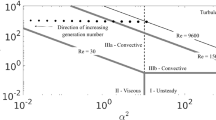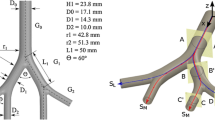Abstract
The objective of this work is to develop understanding of the local fluid dynamic mechanisms that underpin gas exchange in high-frequency oscillatory ventilation (HFOV). The flow field during HFOV was investigated experimentally using particle image velocimetry in idealized and realistic models of a single bifurcation. Results show that inspiratory and expiratory fluid streams coexist in the airway at flow reversal, and mixing between them is enhanced by secondary flow and by vortices associated with shear layers. Unsteady flow separation and recirculation occurs in both geometries. The magnitude of secondary flow is greater in the realistic model than in the idealized model, and the structure of secondary flow is quite different. However, other flow structures are qualitatively similar.








Similar content being viewed by others
References
The Acute Respiratory Distress Syndrome Network. Ventilation with lower tidal volumes as compared with traditional tidal volumes for acute lung injury and the acute respiratory distress syndrome. N. Engl. J. Med. 342:1301–1308, 2000. doi:10.1056/NEJM200005043421801
Banvard, R. A. The Visible Human Project image data set from inception to completion and beyond. Proceedings of CODATA 2002: Frontiers of Scientific and Technical Data, Montreal, Canada, 2002
Bryan A. C. (2001) The oscillations of HFO. Am. J. Respir. Crit. Care Med. 163:816–817
Chang H. K. (1984) Mechanisms of gas transport during ventilation by high-frequency oscillation. J. Appl. Physiol., 56: 553–563
Comer J. K., C. Kleinstreuer, Z. Zhang (2001) Flow structures and particle deposition patterns in double-bifurcation airway models. Part 1. Air flow fields. J. Fluid Mech. 435:25–54. doi:10.1017/S0022112001003809
Derdak, S., S. Mehta, T. E. Stewart, T. Smith, M. Rogers, T. G. Buchman, B. Carlin, S. Lowson, J. Granton, and the Multicenter Oscillatory Ventilation for Acute Respiratory Distress Syndrome Trial (MOAT) Study Investigators. High-frequency oscillatory ventilation for acute respiratory distress syndrome in adults: a randomized, controlled trial. Am. J. Respir. Crit. Care Med. 166:801–808, 2002. doi:10.1164/rccm.2108052
Eckmann D. M., J. B. Grotberg (1988) Oscillatory flow and mass transport in a curved tube. J. Fluid Mech. 188:509–527. doi:10.1017/S0022112088000825
Fresconi F. E., A. S. Wexler, A. K. Prasad (2003) Expiration flow in a symmetric bifurcation. Exp. Fluids 35: 493–501. doi:10.1007/s00348-003-0713-y
Fujioka H., K. Oka, K. Tanishita (2001) Oscillatory flow and gas transport through a symmetrical bifurcation. J. Biomech. Eng. 123:145–153. doi:10.1115/1.1352735
Gerrard J. H., M. D. Hughes (1971) The flow due to an oscillatory piston in a cylindrical tube: a comparison between experiment and a simple entrance flow theory. J. Fluid Mech. 50:97–106. doi:10.1017/S0022112071002477
Große S., W. Schröder, M. Klaas, A. Klöckner, J. Roggenkamp (2007) Time resolved analysis of steady and oscillating flow in the upper human airways. Exp. Fluids 42: 955–970. doi:10.1007/s00348-007-0318-y
Haselton F. R., P. W. Scherer (1982) Flow visualization of steady streaming in oscillatory flow through a bifurcating tube. J. Fluid Mech. 123:315–333. doi:10.1017/S0022112082003085
Insight 3GTM Data Acquisition Analysis and Display Software User Guide. Shoreview: TSI Inc., 2006
Jan D. L., A. H. Shapiro, R. D. Kamm (1989) Some features of oscillatory flow in a model bifurcation. J. Appl. Physiol. 67:147–159
Kelly J. T., A. K. Prasad, A. S. Wexler (2000) Detailed flow patterns in the nasal cavity. J. Appl. Physiol. 89:323–337
Krishnan J. A., R. G. Brower (2000) High frequency ventilation for acute lung injury and ARDS. Chest 118:795–807. doi:10.1378/chest.118.3.795
Lieber B. B., Y. Zhao (1998) Oscillatory flow in a symmetric bifurcation airway model. Ann. Biomed. Eng. 26:821–830. doi:10.1114/1.128
Marchak B. E., W. K. Thompson, P. Duffty, T. Miyaki, M. H. Bryan, A. C. Bryan, A. B. Froese (1981) Treatment of RDS by high-frequency oscillatory ventilation: a preliminary report. J. Pediatr. 99:287–292. doi:10.1016/S0022-3476(81)80480-5
Mehta S., J. Granton, R. J. MacDonald, D. Bowman, A. Matte-Martyn, T. Bachman, T. Smith, T. E. Stewart (2004) High-frequency oscillatory ventilation in adults: the Toronto experience. Chest 126:518–527. doi:10.1378/chest.126.2.518
Moganasundram S., A. Durward, S. M. Tibby, I. A. Murdoch (2002) High-frequency oscillation in adolescents. Br. J. Anaesth. 88:708–711. doi:10.1093/bja/88.5.708
Nishida M., Y. Inaba, K. Tanishita (1997) Gas dispersion in a model pulmonary bifurcation during oscillatory flow. J. Biomech. Eng. 119:309–316. doi:10.1115/1.2796095
Nowak N., P. P. Kakade, A. V. Annapragada (2003) Computational fluid dynamics simulation of airflow and aerosol deposition in human lungs. Ann. Biomed. Eng. 31:374–390. doi:10.1114/1.1560632
Olson, D. E. Fluid mechanics relevant to respiration—flow within curved or elliptical tubes and bifurcating systems. Ph.D. Thesis, London University, London, 1971
Peattie R. A., W. Schwarz (1998) Experimental investigation of oscillatory flow through a symmetrically bifurcating tube. J. Biomech. Eng. 120:584–593. doi:10.1115/1.2834748
Raffel, M., C. Willert, and J. Kompenhans. Particle Image Velocimetry: A Practical Guide. Berlin: Springer-Verlag, 1998
Ramuzat, A., and M. L. Riethmuller. PIV investigation of oscillating flows within a 3D lung multiple bifurcations model. 11th International Symposium on Application of Laser Techniques to Fluid Mechanics, Lisbon, Portugal, 2002
Rimensberger P. C., M. Beghetti, S. Hanquinet, M. Berner (2000) First intention high-frequency oscillation with early lung volume optimization improves pulmonary outcome in very low birth weight infants with respiratory distress syndrome. Pediatrics 105:1202–1208. doi:10.1542/peds.105.6.1202
Rubenfeld G. D. (2003) Epidemiology of acute lung injury. Crit. Care Med. 31:S276–284. doi:10.1097/01.CCM.0000057904.62683.2B
Schroter R. C., M. F. Sudlow (1969) Flow patterns in models of the human bronchial airways. Respir. Physiol. 7:341–355. doi:10.1016/0034-5687(69)90018-8
Tanaka G., T. Ogata, K. Oka, K. Tanishita (1999) Spatial and temporal variation of secondary flow during oscillatory flow in model human central airways. J. Biomech. Eng. 121:565–573. doi:10.1115/1.2800855
Tanaka G., Y. Ueda, K. Tanishita (1998) Augmentation of axial dispersion by intermittent oscillatory flow. J. Biomech. Eng. 120:405–415. doi:10.1115/1.2798008
Taylor G. (1953) Dispersion of soluble matter in solvent flowing slowly through a tube. Proc. R. Soc. Lond. A Math. Phys. Sci. 219: 186–203. doi:10.1098/rspa.1953.0139
Taylor G. (1954) The dispersion of matter in turbulent flow through a pipe. Proc. R. Soc. Lond. A Math. Phys. Sci. 223: 446–468. doi:10.1098/rspa.1954.0130
Weibel E. R. (1963) Morphometry of the Human Lung. New York: Academic Press
Womersley J. R. (1955) Method for the calculation of velocity, rate of flow and viscous drag in arteries when their pressure gradient is known. J. Appl. Physiol. 127:553–563
Acknowledgments
The authors are grateful to Ms. Sue Harty and Dr. Gerard O’Sullivan of the Merlin Park Imaging Centre for providing CT images of the models. We also thank Mr. Colm Walsh and Mr. Kumar Saidha for their contributions to the development of the flow apparatus. This research was supported by the Irish Research Council for Science, Engineering and Technology, funded by the National Development Plan; the Programme for Research in Third Level Institutions; and National University of Ireland, Galway through the Millennium Research Fund.
Author information
Authors and Affiliations
Corresponding author
Rights and permissions
About this article
Cite this article
Heraty, K.B., Laffey, J.G. & Quinlan, N.J. Fluid Dynamics of Gas Exchange in High-Frequency Oscillatory Ventilation: In Vitro Investigations in Idealized and Anatomically Realistic Airway Bifurcation Models. Ann Biomed Eng 36, 1856–1869 (2008). https://doi.org/10.1007/s10439-008-9557-1
Received:
Accepted:
Published:
Issue Date:
DOI: https://doi.org/10.1007/s10439-008-9557-1




